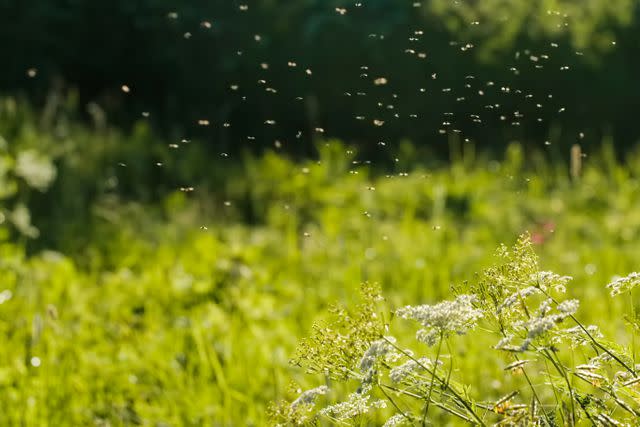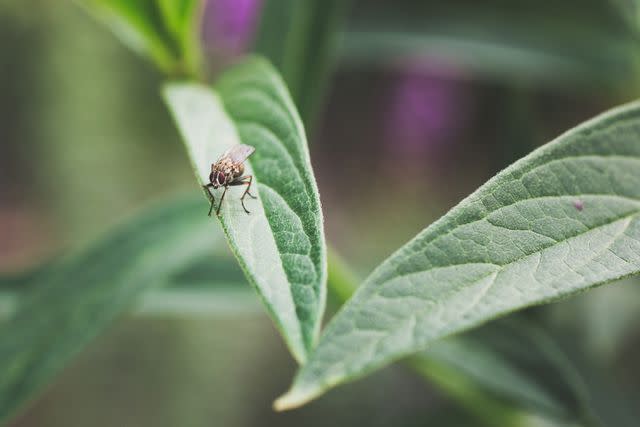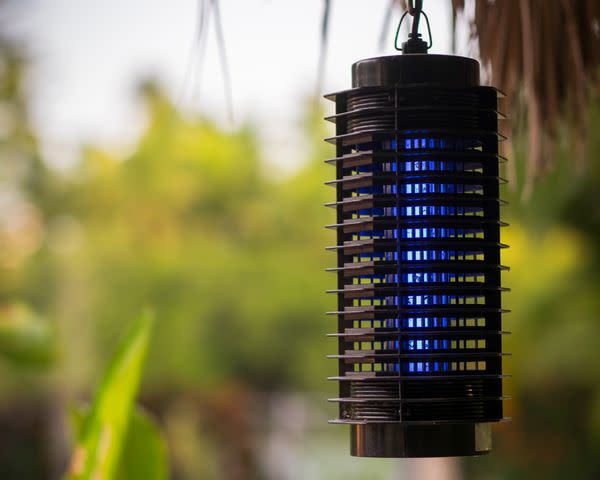These Are the Right Ways to Get Rid of Flies Outside
We asked experts which fly elimination techniques work and which ones don’t. Here’s what they told us about keeping flies away.
Nobody enjoys having a fly buzzing around their face or walking across their dinner. And when a fly does land on your food, it’s carrying germs that are best kept away from something you’re about to eat.
Houseflies and blow flies are the ones you probably deal with most around your house—they’re among the species scientists refer to as "filth flies." Dealing with a couple of flies is one thing, but you will probably want to address an entire infestation of them. We spoke with experts to understand what causes a fly infestation and how to get rid of them outside your home effectively.
Meet Our Expert
Dana Nayduch, research leader of the Arthropod-Borne Animal Diseases Research Unit at the United States Department of Agriculture
Karim Gharbi, entomologist and horticulturist with Colorado State University Extension
Edwin R. Burgess IV, assistant professor in medical and veterinary entomology at the University of Florida
Related: 8 Things That Attract Bugs and Pests to Your Yard—and How to Prevent Them

Media Whalestock / GETTY IMAGES
What Are the Signs of a Fly Infestation?
If a few flies are buzzing your porch or patio, that’s a problem you and your fly swatter can handle. But if a fly infestation is brewing, you’ll see these signs:
Emergence of Larvae
You might see larvae in your trash can or on organic material, like dog waste or an animal that's died outside. Also known as maggots, housefly and blowfly larvae look like small white worms. Even if you don’t see them, you might see the trash in your bin moving when you open the lid. You might also see them moving en masse across your driveway or patio as they continue through the phases of metamorphosis.
Yellow Jackets or Paper Wasps in the Area
"A lot of scavenging hornets are attracted to the same sources of food that the flies are attracted to," says Karim Gharbi, horticulturist with Colorado State University Extension. "So if you have rotting meat in your garbage, that's going to attract flies, and it's also going to attract yellow jackets who want a bite of that meat." The hornets will also feed on the maggots if there are enough of them, he says.
A Flying Dance Party
Depending on the temperature, the young adult flies will break out a few days or several weeks later. That’s when you’ll see them buzzing around your outdoor space, looking for new food sources and getting to know each other for a new round of reproduction.
Clusters of Black Dots Around Trash Bins or Deck Furniture
Even if you don’t see the flies, you’ll see what they leave behind, especially if you have white patio furniture.
What Causes a Fly Infestation?
To understand how fly infestations happen, it helps to understand flies. Dana Nayduch, who studies them for the USDA, can help with that. "Their goal in life is to make a lot more flies," she says. "That’s it."
In a female fly’s hunt for good places to eat, mate, and lay her eggs, she’s looking for a mix of things, including protein for her own meals and an environment rich in bacteria and other microbes that will sustain her kids. She might find what she’s looking for in a combination of stuff, like scraps of meat in your trash can, a vegetable garden you haven’t cleared out, the dog waste you haven’t picked up in a while, or an animal that died in the woods behind your house. Her ideal location will provide everything she needs, says Gharbi. "It's a nursery, a buffet, and also a wedding venue, all at the same time," he says.
From there, she’s capable of single-handedly creating an infestation, laying as many as 500 eggs over three or four days. Your best move is to find food and breeding sources in your yard and eliminate them before that happens (more on that below). But if the problem is spilling over from a neighbor’s farm or property, or if you just want to be extra thorough before a backyard birthday party, you have options.
How to Get Rid of Flies Outside

Annie Otzen / GETTY IMAGES
Our experts recommend these resources for keeping filth flies away from your outdoor spaces.
Fly Traps
Designed to lure flies in and keep them from escaping, traps are affordable and work very well, says Edwin Burgess, an entomologist with the University of Florida. You’ll find them online or in your neighborhood hardware store and can purchase them ready to fill with your own goodies, like chicken bones, or preloaded with organic compounds.
Called putrescine and cadaverine, these compounds smell as bad as they sound, Burgess says. Placing the traps away from your patio or deck won’t create a fly-free experience, "but it certainly can help," he says.
Fly Tape
Another hardworking option, fly tape can work well in a garage or near a backyard chicken coop. You can tuck a strip around a corner or near a downspout to keep it from ruining your aesthetic.
Why it works: "Flies like to perch, especially on dangling things, while they rest," Burgess says. "So fly tapes are specifically designed to attract that behavior of the flies."
Spiders
Resist the urge to kill these arachnid architects, and you’ll have ongoing help in reducing flies around your outdoor space. In one study, researchers concluded that the world’s spiders feed on 400 to 800 million tons of insects and other pests per year—up to twice as much protein as humans consume in meat and fish.
Feel free to take down any webs around your porch or patio if no spiders are visible on them since most spiders replace them daily.
Tiny Wasps
Parasitoids can be effective, Burgess says. These ant-sized insects are harmless to you but deadly to flies. Adults feed on pollen and nectar from flowers—they don’t sting or create and protect nests. They also won’t want to get inside your house or eat the food on your plate.
What they will want to do is to find fly pupae. A female will lay each of her eggs directly into a fly pupa, which will become food for her own baby. "Then they emerge and mate and go and do it all over again," Burgess says.
And because parasitoid wasps tend to stick around, your initial purchase will continue to pay off, especially if the source of your flies is ongoing and beyond your control. Prices start at around $5; search Amazon for "parasitoid wasps for filth fly extermination."
Scents
Essential oils can help repel flies, Burgess says, although he considers them a costly option. "And you're talking about having those kinds of very pungent odors around you while you're sitting on your deck," he says. "If you’re trying to eat or sipping a cocktail or something like that, they can be off-putting to some."
Candles
Some people recommend citronella candles to deter flies. And while they can help, Burgess isn’t sold. "Mosquitoes are very repelled by the smoke and odors that emanate from them," he says. "But the little bit of smoke that those give off—flies don't seem to mind it as much." Bottom line: "They are somewhat better than nothing, but not as good as they are for mosquitoes," Burgess says.
Mitigating Food Sources
Your best line of defense is eliminating the stuff flies love. "They're a nuisance to you because they're looking for food or breeding habitat," Nayduch says. "And if you're leaving out stuff that smells great to them, they’re going to just follow their nose in search of those things."
If they’re attracted to the goo in the bottom of your trash can, rinse it out. You can pour the water on the pavement to dry in the sun or on the ground, where a healthy soil microbiome will outcompete the pathogenic and pestiferous microbes from the trash can, Gharbi says.
If blow flies (the shiny green ones) are gathering on the dog poop in your yard, try to get to it sooner before they lay their eggs on it and compound the problem. If you discover that an animal has died nearby, consider hiring a professional or calling in animal control to remove it, Gharbi says.
Related: 10 Plants That Will Keep Mosquitoes Out of Your Yard
What Not to Use to Get Rid of Flies

Tuned_In / GETTY IMAGES
Many popular solutions for eliminating flies aren’t worth your time or money, according to our experts.
Fans
Have you ever watched someone bring out fans to shoo flies away from the hot dishes at a potluck? It seems like such a good idea—until you see the flies helping themselves, too. "Flies are strong flyers," Burgess says. "They can travel long distances, and they can basically endure windy conditions that other types of flying insects don't always deal with very well."
Birds
You may have read that inviting more birds to your yard can help control flies. But this actually doesn't help very much. "A lot of birds are not as insectivorous as people think they are," says Burgess. "Most of them are foraging for other things, like seeds, fruits, and shoots on plants, to make up their omnivorous diets. Insects are not the main thing on the menu for them."
Bats
Yes, you can install bat houses in your yard, and your new guests will eat a lot of mosquitoes. Just don’t expect them to help out with the fly problem. "Bats are nocturnal feeders," Burgess says. "And house flies and filth flies are not going to be flying around at night, when the bats are."
Bug Zappers
These devices emit UV or fluorescent light to attract bugs and then kill them with electrified wire meshes. But they also attract other insects we don't want to kill. "The bug zapper will also kill butterflies and moths—just about any flying insect that uses light to navigate," says Gharbi.
Given an unprecedented decline in insect diversity throughout the world, he says, it’s worth caring about, especially when there are targeted alternatives. "A fly trap will only kill flies because it usually has either organic material or it's laced with the pheromone that the flies use to mate,” he says. “So they are selectively attracted to that."
Vodka in Bags
As the story goes, flies hate the smell of vodka, so you can drive them off by filling plastic bags with the clear liquid, poking holes near the tops of the bags, and hanging them from tree branches. "That's an old wives’ tale that goes way, way back," Burgess says. "And it does not work at all. It has actually been debunked through research." Even worse, he says, the vodka could attract fruit flies.
Waiting for Cold Weather
Don’t count on Old Man Winter to take care of your fly problem. Flies overwinter as larvae or pupae under the soil and in other protected places, Nayduch says. Those nice spring days that draw you outside are also their invitation to emerge and get on with their lives.
When to Call a Professional to Treat Flies
Contact a professional pest control company to help with fly control only if you have exhausted all your other options, our experts say. "But also get a second opinion," Gharbi says. "Because sometimes the pest control companies will recommend treatments that don't really address the root of the problem. And just spraying chemicals without addressing the root of the problem is going to ensure that you have a continued fly infestation, and the pest control company is going to have a continued source of business from you."
Tips
A quick note on chemicals: In addition to the potential risks of using chemicals, a lot of the chemical products designed to kill flies aren’t registered for use outside, our experts said. Further, any flies that survive chemical treatments will likely hatch new offspring that can resist them. "So now, all of a sudden, you're multiplying the frequency of these resistance genes," Burgess says.
Even if you do all the right things, you’ll likely have some flies dropping by when you eat outside. "Houseflies go where they need to go to reproduce and eat," Nayduch says. "They are cosmopolitan—they have worldwide distribution. And so they can travel great distances if they have to." Try wire or plastic food covers to keep them from dining on any dishes you serve buffet-style, or use a pop-up screened enclosure to enjoy a fly-free meal on your patio or porch.
Read the original article on Martha Stewart.

